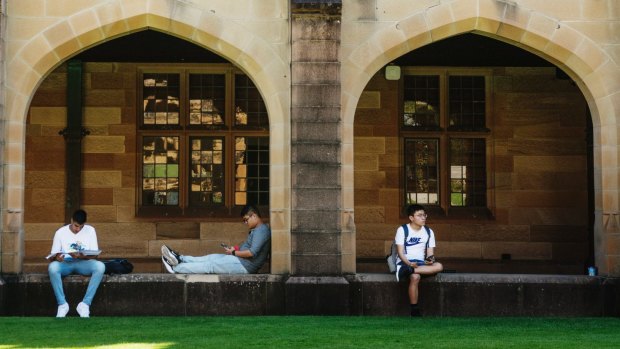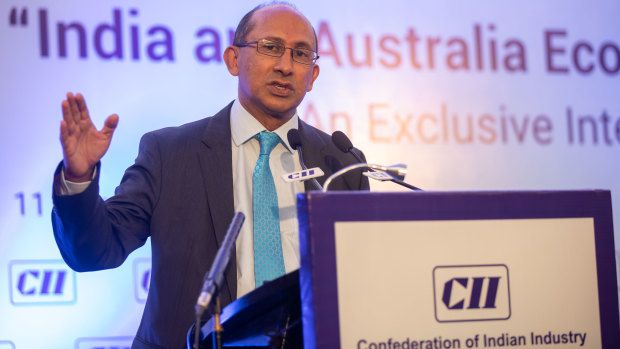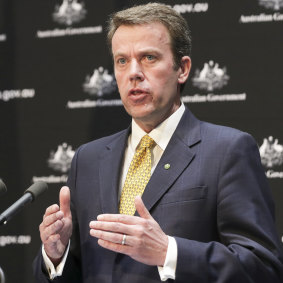This was published 3 years ago
Never waste a crisis: will COVID-19 be a catalyst for change at Australia's universities?
Ten years ago, Australia's international education sector was in crisis mode.
Economic headwinds, scandals in vocational educational and a series of well-publicised attacks on students had seen the number of Indians seeking Australian qualifications crater.

Universities are looking at losses of $4.6 billion or more in the next six months, with 21,000 jobs on the line.Credit: Louise Kennerley
Between 2009 and 2011, Indian student numbers dropped from 26,000 to 10,000, quickly wiping $225 million from university budgets. Longer term, the downturn deprived them of an estimated $1.3 billion. The contraction was viewed by some as a painful lesson in risk but the impact was mitigated by the unstoppable rise of one market: China.
A decade on, after consistent annual growth in international education of around 14 per cent, it is over-exposure to the Chinese market in particular that is the source of the sector's woes. And the shock from the COVID-19 pandemic makes the previous Indian student downturn look trivial.
'It’s an extraordinary impact. Profound and far-reaching."
Western Sydney University vice-chancellor Barney Glover
Universities are looking at losses of $4.6 billion or more in the next six months, with 21,000 jobs on the chopping block, according to peak body Universities Australia. Modelling by Victoria University's Mitchell Institute projects the blow could be up to $19 billion over three years.
"It’s an extraordinary impact. Profound and far-reaching," says Western Sydney University vice-chancellor Barney Glover. "I don't think we have faced anything like this in higher education at any time, certainly in the last 30 years."
The pain started early for universities, as soon as the government's initial ban on non-citizens travelling from China was imposed in early February, stranding over 100,000 students offshore. Large numbers of Indians, Vietnamese, South Koreans, Brazilians and others have also been locked out. The number of onshore international students in higher education is now sitting at 330,000, down about 30 per cent on last year.
Institutions have since put major capital works on hold, frozen non-essential spending and started negotiating with the union to minimise job losses. The federal government has guaranteed $18 billion in funding for domestic education and unveiled new online short courses but the package does not address the shortfall in international education revenue. Universities are also struggling to meet the revenue downturn thresholds required to qualify for JobKeeper wage subsidy payments.
The extent of the impact will depend on what happens with the government's travel restrictions and the pace of global recovery from the pandemic. International student numbers will still be significantly depressed in semester two.
"My sense is that most universities will take a big hit in 2020 but it will not be terminal because they are taking strong finance measures ... but the impact will vary from university to university," says University of Queensland chancellor Peter Varghese, a former secretary of the Department of Foreign Affairs and Trade.

University of Queensland chancellor Peter Varghese says the impact will vary from university to university.Credit: Cameron Laird
"I think if we find ourselves in 2021 with international students unable to enrol in Australian universities then we are in a completely different ballgame and completely different world of pain."
Education Minister Dan Tehan won't be drawn on when travel restrictions might be eased for international students. He says reopening campuses for domestic students and international students already in Australia is the priority.
"My hope is that we will hear sooner rather than later about a move back to campuses being reopened, with adherence to the Australian Health Protection Principal Committee guidelines around social distancing. But campuses will be looking to reopen for semester two," he says.
Institutions are also anxious to make sure international students currently in Australia, having lost work and facing barriers to returning home, are looked after. If they aren't, many won't be in a position to pay fees and there could be a long-term hit to Australia's reputation, especially as countries like Canada, Britain and New Zealand offer more generous support. Prime Minister Scott Morrison also shocked the sector by saying recently that it was "time to go home" for temporary visa holders, including students, if they couldn't support themselves.
"I think it's the messaging and signalling that we need to make sure the government is getting right," says University of Sydney vice-chancellor Michael Spence.
One senior academic figure sees an "overt hostility" towards universities in the government's restrained support for the sector so far. Tehan says Coalition politicians just want to ensure funding is "spent well, taxpayers are getting value for money and institutions are delivering on their core objectives". The government has also emphasised that no sector is immune from the economic ramifications of the pandemic.
Universities are hoping the crisis will convince people of the importance of research – with academics around the country part of critical efforts to tackle COVID-19. And the institutions are billing themselves as key to Australia's economic recovery as people seek to upskill or retrain. They are expecting a spike in demand because of a weak jobs market and Tehan has acknowledged that will need to be funded somehow.
La Trobe University vice-chancellor John Dewar says the sector is ready to participate in preparing the nation's future workforce.

Education Minister Dan Tehan says the sector’s reliance on international education must be assessed.Credit: Alex Ellinghausen
"But it would be nice if government were to reciprocate and to understand just how important universities can be in that process," Dewar says.
The high-stakes crisis has triggered a reappraisal of the business model that has prevailed in universities over recent decades. The growth of international education has been a shared endeavour with Labor and Coalition governments, who encouraged universities to diversify their revenue streams, taking the pressure off the public purse. The government accounted for around 85 per cent of university funding in 1990; today, it is 30 per cent.
"I think the business model was already being assessed in the lead up to COVID-19 although there is no doubt that the pandemic has led to more urgent thinking about the sector’s reliance on international education," says Tehan.
While noting the efforts to diversify source countries of students, he wants to see international education "rebounding strongly" after the crisis and argues Australia's success in dealing with COVID-19 will make it an attractive destination.
The relentless growth of international education has seen it become Australia's third-largest export earner, behind only iron ore and coal. It has become a pillar of budgets – worth $39 billion last year. Among the elite Group of Eight universities, fee-paying overseas students account for 27 per cent of revenue, up from 6 per cent 20 years ago.
Universities are quick to add this is not just about the money. They have talked up the infusion of multicultural talent on campuses and the goodwill towards Australia generated among hundreds of thousands alumni spread throughout Asia.
Labor education spokeswoman Tanya Plibersek says the university funding model needs to be scrutinised after the crisis. She thinks there is a "middle ground" to be found where governments provide more funding for education and research.
"Putting international education on a stronger and more sustainable footing will be part of that. Making sure there is adequate funding for education and research is a really important part of that. There must be a greater role for public funding," she says.
"I think universities have been pretty conscious of the risks of over-dependence on one market," says Varghese.
"Every university has been aware for some time of that and has strategies for diversifying their sources of international students. But the reality is that while Chinese demand remained very high, those diversification strategies didn’t advance as easily as people might have hoped."
Previously, the tumultuous political relationship between Beijing and Canberra was the more apparent risk in over-reliance on Chinese students. The political risk was underscored last week when Chinese ambassador Cheng Jingye, criticising the Morrison government's pursuit of an independent inquiry into the origins of COVID-19, warned of a potential boycott by Chinese parents who might reconsider "whether this is the best place to send their kids".
People's thoughts on what should happen with international student numbers are one thing. But the inevitable reality is that enrolments, from China and elsewhere, could be suppressed long-term because of the COVID-19 shock. Up to now, international education revenue has cross-subsidised research, allowing Australian institutions to climb in global rankings, and allowed them to invest significantly in their campuses.
"The real issue here is if we lose the revenue from international students, what takes its place?" wonders Varghese.
Is there any appetite whatsoever inside government for an increase in funding for universities?
"I don’t think that has been tested because while international student revenue has been flowing in, the government really hasn’t had to face up to that question," he says.
Dewar thinks international student revenue may take two to five years to recover and "that will sharpen the focus on what government can and will do for the sector".
"I'm sure it will be the catalyst for some changes," he says.
"It is arguable that the current model is not fit for the long term post-COVID recovery and we need new ideas recognising that higher education is crucial to a knowledge economy and community resilience," says Glover, including a "need to consider the level of commonwealth investment and the relative private versus public contribution to the costs".
While philanthropy and commercialisation can yield valuable revenue for Australian universities, there are only two sources of funding that can realistically underpin their budgets: government grants and student fees. Six years ago, the Coalition government tried to uncap fees for domestic students, which would have allowed universities to charge significantly more. The measure faced major political hostility and was ultimately withdrawn.
Spence says philanthropy and commercialisation help but are not the main game. "It's student fees or government grants. So there has to be movement in one or the other," he warns.
Plibersek is cold on the idea of revisiting deregulation of domestic fees. "Australians students already pay a larger share of their university education than most comparable countries. If people earn a high income because of their university education, they should pay more tax in our progressive tax system," she says.
Tehan is not quite ready to engage with the difficult longer term questions about the sector and says the first priority is getting through the crisis.
"Let’s get the campuses open," he says.
Sign up to our Coronavirus Update newsletter